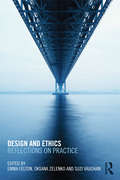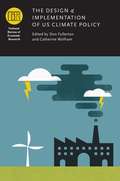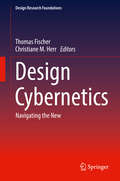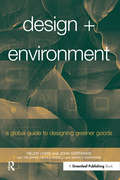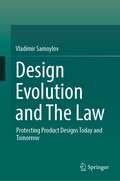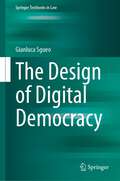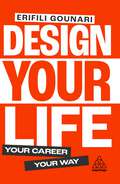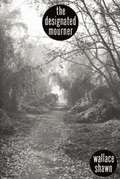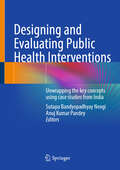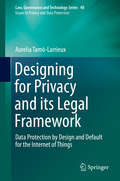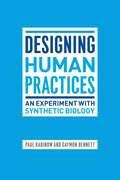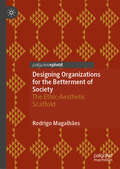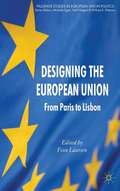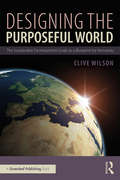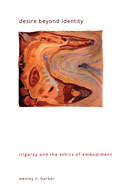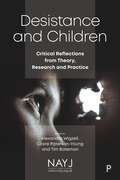- Table View
- List View
Design and Ethics: Reflections on Practice
by Emma Felton Oksana Zelenko Suzi VaughanThe value of design for contributing to environmental solutions and a sustainable future is increasingly recognised. It spans many spheres of everyday life, and the ethical dimension of design practice that considers environmental, social and economic sustainability is compelling. Approaches to design recognise design as a practice that can transform human experience and understanding, expanding its role beyond stylistic enhancement. The traditional roles of design, designer and designed object are therefore redefined through new understanding of the relationship between the material and immaterial aspects of design where the design product and the design process are embodiments of ideas, values and beliefs. This multi-disciplinary approach considers how to create design which is at once aesthetically pleasing and also ethically considered, with contributions from fields as diverse as architecture, fashion, urban design and philosophy. The authors also address how to teach design based subjects while instilling a desire in the student to develop ethical work practices, both inside and outside the studio.
The Design and Implementation of US Climate Policy
by Don Fullerton Catherine WolframEconomic research on climate change has been crucial in advancing our understanding of the consequences associated with global warming as well as the costs and benefits of the various policies that might reduce emissions of greenhouse gases. As nations work to develop climate policies, economic insights into their design and implementation are ever more important. With a balance between theoretical and empirical approaches, The Design and Implementation of US Climate Policy looks at the possible effects of various climate policies on a range of economic outcomes. The studies that comprise the volume examine topics that include the coordination--or lack thereof--between the federal and state governments, implications of monitoring and enforcing climate policy, and the specific consequences of various climate policies for the agricultural, automotive, and buildings sectors.
Design Cybernetics: Navigating the New (Design Research Foundations)
by Thomas Fischer Christiane M. HerrDesign Cybernetics: Navigating the New Design cybernetics offers a way of looking at ourselves – curious, creative, and ethical humans – as self-organising systems that negotiate their own goals in open-ended explorations of the previously unknown. It is a theory of and for epistemic practices (learning, designing, researching) that is deeply committed to the autonomy of others and hence offers no prescriptive methodology. Design cybernetics describes design practice as inextricable from conversation – a way of enquiring, developing shared understanding and reaching the new that harnesses reliable control as well as error and serendipity. Recognising circular causality, observer-dependency and non-determinability, design cybernetics extends beyond tenets of scientific research into the creative, ethical and aesthetic domain. From this perspective, design is not an ill-conceived subset of scientific research. Instead, scientific research emerges as a particularly restricted subset of the broader human activity of design. This volume offers a cross-section of design cybernetic theory and practice with contributions ranging across architecture, interior lighting studies, product design, embedded systems, design pedagogy, design theory, social transformation design, research epistemology, art and poetics, as well as theatre and acting. Addressing designers, design educators and researchers interested in a rigorous, practice-based epistemology, it establishes design cybernetics as a foundational perspective of design research. “This is a conceptually elegant, well structured, and comprehensive presentation of design cybernetics. It fills a gap in the literature of the field.” Ken Friedman, Chair Professor, Tongji University “This book offers a valuable and timely introduction to second-order cybernetics as society grapples with complex issues like climate change and rising inequality.” Joichi Ito, Director of the MIT Media Lab
Design + Environment: A Global Guide to Designing Greener Goods
by Helen Lewis John Gertsakis Tim Grant Nicola Morelli Andrew SweatmanThere is a huge scarcity of good, practical resources for designers and students interested in minimizing the environmental impacts of products. Design + Environment has been specifically written to address this paucity. The book first provides background information to help the reader understand how and why design for environment (DfE) has become so critical to design, with reference to some of the most influential writers, designers and companies in the field. Next, Design + Environment provides a step-by-step approach on how to approach DfE: to design a product that meets requirements for quality, cost, manufacturability and consumer appeal, while at the same time minimising environmental impacts. The first step in the process is to undertake an assessment of environmental impacts, using life-cycle assessment (LCA) or one of the many simpler tools available to help the designer. From then on, DfE becomes an integral part of the normal design process, including the development of concepts, design of prototypes, final design and development of marketing strategies. Environmental assessment tools and strategies to reduce environmental impacts, such as the selection of appropriate materials, are then discussed. Next, some of the links between environmental problems, such as global warming, ozone depletion, water and air pollution and the everyday products we consume are considered. In order to design products with minimal environmental impact, we need to have a basic understanding of these impacts and the interactions between them. The four subsequent chapters provide more detailed strategies and case studies for particular product groups: packaging, textiles, furniture, and electrical and electronic products. Guidelines are provided for each of the critical stages of a product's life, from the selection of raw materials through to strategies for recovery and recycling. Finally, Design + Environment takes a look at some of the emerging trends in DfE that are offering us the opportunity to make a more significant reduction in environmental impacts. Both the development of more sustainable materials and technologies and the growing interest in leasing rather than selling products are examined. Design + Environment is organized as a workbook rather than an academic text. It should be read once, and then used as a key reference source. This clear and informative book will prove to be invaluable to practising designers, to course directors and their students in need of a core teaching and reference text and to all those interested in learning about the tools and trends influencing green product design. The authors have all been involved in an innovative demonstration programme called "EcoReDesign", which was developed by the Centre for Design at RMIT University with funding from the Australian government. The Centre successfully collaborated with Australian companies to improve the environmental performance of their products by following DfE principles.
Design Evolution and The Law: Protecting Product Designs Today and Tomorrow
by Vladimir SamoylovThis book focuses on product design which is evolving conceptually and practically with advances in technology. Product design is no longer solely about product stylization and decoration, but rather about providing a holistic product experience for the consumer. Therefore, in the foreseeable future, product designs will increasingly communicate not only to our eyes, but to our other senses as well.This book examines the frameworks for the protection of product designs in New Zealand and Australia and evaluates the appropriateness of expanding legal mechanisms for the accommodation of product design evolution. The value of more holistic design protection is balanced against other important considerations such as the “right to repair".The book not only anticipates the extent to which product design will cater to senses other than visual, but also provides a novel framework (with reference to industry examples) for discerning originality in such work for the purposes of copyright. This book also makes suggestions for how designs can be protected from foreseeable infringement (analogous to copyright infringement of music and movies on file sharing networks) resulting from future advances in technologies such as 3D printing and virtual reality.
Design for Liberty: Private Property, Public Administration, and the Rule of Law
by Richard A. EpsteinFollowing a vast expansion in the twentieth century, government is beginning to creak at the joints under its enormous weight. The signs are clear: a bloated civil service, low approval ratings for Congress and the President, increasing federal-state conflict, rampant distrust of politicians and government officials, record state deficits, and major unrest among public employees. In this compact, clearly written book, the noted legal scholar Richard Epstein advocates a much smaller federal government, arguing that our over-regulated state allows too much discretion on the part of regulators, which results in arbitrary, unfair decisions, rent-seeking, and other abuses. Epstein bases his classical liberalism on the twin pillars of the rule of law and of private contracts and property rights—an overarching structure that allows private property to keep its form regardless of changes in population, tastes, technology, and wealth. This structure also makes possible a restrained public administration to implement limited objectives. Government continues to play a key role as night-watchman, but with the added flexibility in revenues and expenditures to attend to national defense and infrastructure formation. Although no legal system can eliminate the need for discretion in the management of both private and public affairs, predictable laws can cabin the zone of discretion and permit arbitrary decisions to be challenged. Joining a set of strong property rights with sound but limited public administration could strengthen the rule of law, with its virtues of neutrality, generality, clarity, consistency, and forward-lookingness, and reverse the contempt and cynicism that have overcome us.
Design in Legal Education (Emerging Legal Education)
by Emily AllbonThis visually rich, experience-led collection explores what design can do for legal education. In recent decades design has increasingly come to be understood as a resource to improve other fields of public, private and civil society practice; and legal design—that is, the application of design-based methods to legal practice—is increasingly embedded in lawyering across the world. It brings together experts from multiple disciplines, professions and jurisdictions to reflect upon how designerly mindsets, processes and strategies can enhance teaching and learning across higher education, public legal information and legal practice; and will be of interest and use to those teaching and learning in any and all of those fields.
Design Management Case Studies
by David Hands Jack Ingram Robert JerrardFirst Published in 2002. Routledge is an imprint of Taylor & Francis, an informa company.
The Design of Digital Democracy (Springer Textbooks in Law)
by Gianluca SgueoEver-stronger ties between technology, entertainment and design are transforming our relationship with democratic decision-making. When we are online, or when we use digital products and services, we tend to focus more on certain factors like speed of service and user-friendliness, and to overlook the costs – both for ourselves and others. As a result, a widening gap separates our expectations of everything related to digitalization – including government – and the actual practice of democratic governance. Democratic regulators, unable to meet citizens’ demands for tangible, fast and gratifying returns, are seeing the poorest results ever recorded in terms of interest, engagement and retention, despite using the most cutting-edge technologies. This book explores various aspects of the relationship between democracy, technology and entertainment. These include, on the one hand, the role that digital technology has in strengthening our collective intelligence, nurturing empathic relations between citizens and democratic institutions, and supporting processes of political aggregation, deliberation and collaboration. On the other hand, they comprise the challenges accompanying digital technology for representation, transparency and inclusivity in democratic decision-making. The book’s main argument is that digital democratic spaces should be redesigned to narrow the gap between the expectations and outcomes of democratic decision-making. It suggests abandoning the notion of digital participatory rights as being fast and easy to enjoy. It also refutes the notion that digital democratic decision-making can only be effective when it delivers rapid and successful responses to the issues of the day, regardless of their complexity. Ultimately, the success or failure of digital democracy will depend on the ability of public regulators to design digital public spaces with a commitment to complexity, so as to make them appealing, but also effective at engaging citizens.
Design Your Life: Your Career, Your Way
by Erifili GounariWe don't have to conform to traditional ways of working. Uncover how to build a successful career on your own terms and develop the skills you need for the future with Design Your Life. Why settle with a conventional career path when you can build a future on your own terms? With innovations such as side gigs and personal branding, you can craft your own, authentic future. Design Your Life uncovers the key skills and strategies that will allow you to build a successful career as a young professional. In this book, Gen Z business leader and expert Erifili Gounari draws upon original research and first-hand interviews to uncover how you can thrive and find success in this new world of work, creating a career with flexibility and ownership.
The Designated Mourner
by Wallace Shawn"The play nicely combines Pinterian menace with caustic political commentary." -Time"Acerbic, elusive, poetic and chilling, the writing is demanding in a rarefied manner. Its implications are both affecting and disturbing." -Los Angeles Times"In his exquisitely written dramatic lament for the decline of high culture. . . . [Shawn] offers a definition of the self that should rattle the defenses of intellectual snobs everywhere." -The New York TimesWriter and performer Wallace Shawn's landmark 1996 play features three characters--a respected poet, his daughter, and her English-professor husband--suspected of subversion in a world where culture has come under the control of the ruling oligarchy. Told through three interwoven monologues, the Orwellian political story is recounted alongside the visceral dissolution of a marriage. The play debuted at the Royal National Theatre in London, in a production directed by David Hare, who also directed the film version, starring Mike Nichols and Miranda Richardson. The play's subsequent New York premiere was staged in a long-abandoned men's club in lower Manhattan, directed by Shawn's longtime collaborator André Gregory.Wallace Shawn is the author of Our Late Night (OBIE Award for Best Play), Marie and Bruce, Aunt Dan and Lemon, The Fever, and the screenplay for My Dinner with André. His most recent play, Grasses of a Thousand Colors, premiered last year in London.
The Designation of Marine Protected Areas: A Legal Obligation
by Anna von RebayThis book provides empirical evidence that all States have a universally binding obligation to adopt national laws and international treaties to protect the marine environment, including the designation of Marine Protected Areas. Chapter by chapter this obligation is detailed, providing the foundation for holding States responsible for fulfilling this obligation. The fundamentals are analysed in a preliminary chapter, which examines the legally binding sources of the Law of the Sea as well as its historical development to help readers understand the key principles at hand.The Law of the Sea provides more than 1000 instruments and more than 300 regulations concerning marine protection. While the scope of most treaties is limited either regarding species, regions or activities, one regulation addresses States in all waters: the obligation to protect and preserve the marine environment as stipulated under Art. 192 of the 1982 United Nations Convention on the Law of the Sea (UNCLOS). As this ‘Constitution of the Ocean’ not only contains conventional laws but also very broadly reflects pre-existing rules of customary international law, an extensive analysis of all statements made by States in the UN General Assembly, their practices, national laws and regulations as well as other public testimonials demonstrates that Art. 192 UNCLOS indeed binds the whole community of States as a rule of customary international law with an erga omnes effect. Due to the lack of any objections and its fundamental value for humankind, this regulation can also be considered a new peremptory norm of international law (ius cogens).While the sovereign equality of States recognises States’ freedom to decide if and how to enter into a given obligation, States can also waive this freedom. If States accepted a legally binding obligation, they are thus bound to it. Concerning the specific content of Art. 192 UNCLOS, a methodical interpretation concludes that only the adoption of legislative measures (national laws and international agreements) suffices to comply with the obligation to protect and preserve the marine environment, which is confirmed by the States’ practices and relevant jurisprudence. When applied to a specific geographical area, legislative measures to protect the marine environment concur with the definition of Marine Protected Areas. Nonetheless, as the obligation applies to all waters, the Grotian principle of the freedom of the sea dictates that the restriction of activities through the designation of Marine Protected Areas, on the one hand, must be weighed against the freedoms of other States on the other. To anticipate the result: while all other rights under the UNCLOS are subject to and contingent on other regulations of the UNCLOS and international law, only the obligation to protect and preserve the marine environment is granted absolutely – and thus outweighs all other interests.
Designed to Kill: The Case Against Weapons Research
by John ForgeThe pilot-less drones, smart bombs and other high-tech weapons on display in recent conflicts are all the outcome of weapons research. However, the kind of scientific and technological endeavour has been around for a long time, producing not only the armaments of Nazi Germany and the atomic bombs dropped on Japan, but the catapults used in ancient Greece and Rome and the assault rifles used by child soldiers in Africa. In this book John Forge examines such weapons research and asks whether it is morally acceptable to undertake such an activity. He argues that it is in fact morally wrong to take part in weapons research as its primary purpose is to produce the means to harm others, and moreover he argues that all attempts to then justify participation in weapons research do not stand up to scrutiny. This book has wide appeal in fields of philosophy and related areas, as well to a more general audience who are puzzled about the rate at which new weapons are accumulated.
Designing and Evaluating Public Health Interventions: Unwrapping the key concepts using case studies from India
by Sutapa Bandyopadhyay Neogi Anuj Kumar PandeyThis book covers all aspects of public health interventions, emphasizing the design, implementation, and evaluation of such initiatives. Section I provides information ranging from fundamental concepts of designing an intervention to its implementation and scalability. Section II highlights evidence around interventions to address pressing public health concerns through interesting case studies from India, that offer practical insights for better understanding. This book is relevant for researchers and academicians in public health, epidemiology, health management and economics, health policy, and allied branches. It equips readers to design and analyze interventions to improve practice.
Designing Flexible Cash Flows
by Scott FawcettWhether calculating a net present value, assessing an internal rate of return, or considering the impact of debt on a transaction when analysing investments in property it is very hard to get away from the need for cashflows. These cashflows range from the very simple to the extremely complex and can take anything from minutes to days to produce. Of course, valuation software exists that will produce these for you - but sometimes there are situations where you can't avoid having to do the job yourself!
Designing for Privacy and its Legal Framework
by Aurelia Tamò-LarrieuxThis book discusses the implementation of privacy by design in Europe, a principle that has been codified within the European Data Protection Regulation (GDPR). While privacy by design inspires hope for future privacy-sensitive designs, it also introduces the need for a common understanding of the legal and technical concepts of privacy and data protection. By pursuing an interdisciplinary approach and comparing the problem definitions and objectives of both disciplines, this book bridges the gap between the legal and technical fields in order to enhance the regulatory and academic discourse. The research presented reveals the scope of legal principles and technical tools for privacy protection, and shows that the concept of privacy by design goes beyond the principle of the GDPR. The book presents an analysis of how current regulations delegate the implementation of technical privacy and data protection measures to developers and describes how policy design must evolve in order to implement privacy by design and default principles.
Designing Human Practices: An Experiment with Synthetic Biology
by Paul Rabinow Gaymon BennettIn 2006 anthropologists Paul Rabinow and Gaymon Bennett set out to rethink the role that human sciences play in biological research, creating the Human Practices division of the Synthetic Biology Engineering Research Center—a facility established to create design standards for the engineering of new enzymes, genetic circuits, cells, and other biological entities—to formulate a new approach to the ethical, security, and philosophical considerations of controversial biological work. They sought not simply to act as watchdogs but to integrate the biosciences with their own discipline in a more fundamentally interdependent way, inventing a new, dynamic, and experimental anthropology that they could bring to bear on the center’s biological research. Designing Human Practices is a detailed account of this anthropological experiment and, ultimately, its rejection. It provides new insights into the possibilities and limitations of collaboration, and diagnoses the micro-politics which effectively constrained the potential for mutual scientific flourishing. Synthesizing multiple disciplines, including biology, genetics, anthropology, and philosophy, alongside a thorough examination of funding entities such as the National Science Foundation, Designing Human Practices pushes the social study of science into new and provocative territory, utilizing a real-world experience as a springboard for timely reflections on how the human and life sciences can and should transform each other.
Designing in Ethics
by Seumas Miller Thomas Pogge Jeroen Van Den HovenMany of our interactions in the twenty-first century - both good and bad - take place by means of institutions, technology, and artefacts. We inhabit a world of implements, instruments, devices, systems, gadgets, and infrastructures. Technology is not only something that we make, but is also something that in many ways makes us. The discipline of ethics must take this constitutive feature of institutions and technology into account; thus, ethics must in turn be embedded in our institutions and technology. The contributors to this book argue that the methodology of 'designing in ethics' - addressing and resolving the issues raised by technology through the use of appropriate technological design - is the way to achieve this integration. They apply their original methodology to a wide range of institutions and technologies, using case studies from the fields of healthcare, media and security. Their volume will be important for philosophical practitioners and theorists alike.
Designing Organizations for the Betterment of Society: The Ethic-Aesthetic Scaffold
by Rodrigo MagalhãesThere is an urgent need for the repositioning of organization design in today’s fast-moving technological, social and political environments. Building on the theory of human-centred design as a new foundation of the study of organization, this book offers a detailed model and approach that brings organization design to a new era of ethical and aesthetic concerns for the role of organizations in society. A new managerial role is put forward, the organization designer, as a unique set of responsibilities aimed at ensuring that the principles and values behind the organization’s purpose are not only upheld, but also permeate the entirety of the organization. The book contains a number of concepts that offer a unique contribution to the management literature and which can be applied in practice, perhaps as part of the organization’s regular staff development programs. It will be of great interest to academics and students of organization studies, business ethics, sustainability and strategic management.
Designing Our Descendants: The Promises and Perils of Genetic Modifications (Bioethics)
by Audrey R. Chapman Mark S. FrankelThe Human Genome Project, discoveries in molecular biology, and new reproductive technologies have advanced our understanding of how genetic science may be used to treat persons with genetic disorders. Greater knowledge may also make possible genetic interventions to "enhance" normal human characteristics, such as height, hair or eye color, strength, or memory, as well as the transmittal of such modifications to future generations. The prospect of inheritable genetic modifications, or IGMs, whether for therapeutic or enhancement purposes, raises complex scientific, ethical, and regulatory issues. Designing Our Descendants presents twenty essays by physicians, scientists, philosophers, theologians, lawyers, and policy analysts addressing these issues from diverse perspectives. In three sections, the authors discuss the short- and long-term scientific feasibility of IGM technology; ethical and religious issues related to safety, justice, morality, reproductive rights, and enhancement; and regulatory issues including the necessity of public input and oversight and the influence of commercialization. Their goal is to open a dialogue engaging not only scholars and scientists but also government officials and concerned citizens. The authors conclude that while IGM cannot be carried out safely and responsibly on humans utilizing current methods, it is important to begin public discussion now to determine whether, and if so how, to proceed.
Designing the European Union
by Finn LaursenThis book has chapters on all the treaties establishing the European Communities in the 1950s as well as subsequent treaties reforming these community treaties (Merger Treaty, Budget Treaties, and the Single European Act) followed by chapters on the Maastricht Treaty establishing the European Union in 1993 and subsequent amendments thereof through the Amsterdam, Nice and Lisbon treaties. The authors are all established and well-known scholars of European integration. The book thus traces the 'constitutional' foundation of the European Union (EU) over time and analyses these development from a comparative perspective: who were the main actors, what were their preferences and which institutions did they design to deal with common problems and challenges? Despite the rejection of the proposed Constitutional Treaty in referendums in France and the Netherlands in 2005 the 'constitutionalization' of the EU has continued. The book tries to answer both the 'how' and 'why' questions of this fascinating process.
Designing the Purposeful World: The Sustainable Development Goals as a Blueprint for Humanity
by Clive WilsonIn September 2015, at the United Nations, world leaders agreed on seventeen Sustainable Development Goals or SDGs. This book extrapolates the SDGs into the idea of a purposeful world. In this context, the purpose for humanity is to thrive sustainably alongside other life forms and to consciously celebrate the process. The SDGs serve as a powerful vision, time-stamped at the 2030 time horizon, not just for world leaders but for us all. However, faced with the challenges of implementing the SDGs, we (including business leaders, government leaders and anyone wishing to make a difference) can feel overwhelmed. Wilson takes the reader on a journey of thought and invites them to work out their personal role in sustainability as well as their collaborative role alongside others in their communities and organisations. Written in a very accessible style, the book celebrates some of the many achievements made by ordinary people as a catalyst for hope, sets out a number of achievable goals and provides exercises to enable the reader to adopt practices that help to make a difference. It is the perfect book to help turn the SDGs into action at every level – governmental, organisational and personal.
Desire and Human Flourishing: Perspectives from Positive Psychology, Moral Education and Virtue Ethics (Positive Education)
by Magdalena BoschThis book discusses the concept of desire as a positive factor in human growth and flourishing. All human decision-making is preceded by some kind of desire, and we act upon desires by either rejecting or following them. It argues that our views on and expressions of desire in various facets of life and through time have differed according to how human beings are taught to desire. Therefore, the concept has tremendous potential to affect human beings positively and to enable personal growth. Though excellent research has been done on the concepts of flourishing, character education and positive psychology, no other work has linked the concept of desire to all of these topics. Featuring key references, explanations of central concepts, and significant practical applications of desire to various fields of human thought and action, the book will be of interest to students and researchers in the fields of positive psychology, positive education, moral philosophy, and virtue ethics.
Desire beyond Identity: Irigaray and the Ethics of Embodiment (SUNY series in Gender Theory)
by null Wesley N. BarkerCritically adapts the notion of desire in Luce Irigaray's philosophy to rethink the role of embodiment in sociopolitical and philosophical discourses today.Arguing for a radical return to desire in Luce Irigaray's thought, this book decisively intervenes in impasses around questions of identity that continue to confound contemporary discourse and politics. By prioritizing the disruptive potential of desire rather than sexual difference, Wesley N. Barker extends Irigaray's relational theory of becoming into new territory, opening generative, often surprising pathways for conversation with philosophies of race, queer theory, political theology, decolonial theory, and posthuman thought. As a source for reimagining materiality, desire is pulled free of a phallocentric, white, colonial framework and mobilized toward a philosophy of living capable of addressing the twenty-first century's multifaceted crises of identity, representation, and embodiment.
Desistance and Children: Critical Reflections from Theory, Research and Practice
by Colin Falconer John Wainwright Julie Shaw Martin Stephenson Claire Fitzpatrick Neal Hazel Stephen Case Samantha Burns Jo Staines Kathy Hampson Gilly Sharpe Steve Carr Kirstine Szifris Diana Johns Kevin R Haines Ross Little Katie Hunter Tim Rosier Sean Creaney Andrew Brierley Anne-Marie Douglas Roberta Evans Neema Trivedi-BatemanAvailable open access digitally under CC BY-NC-ND licence. ‘Desistance’ - understanding how people move away from offending – has become a significant policy focus in recent years, with desistance thinking transplanted from the adult to the youth justice system in England and Wales. This book is the first to critique this approach to justice-involved children, many of whom are yet to fully develop an identity (criminal or otherwise) from which to ‘desist’. Featuring voices from academia, policy and practice, this book explores practical approaches to desistance with children in the ‘Child First’ context. It gives new insights into how children can be supported to move away from offending and proposes reforms to make a meaningful difference to children’s lives.
